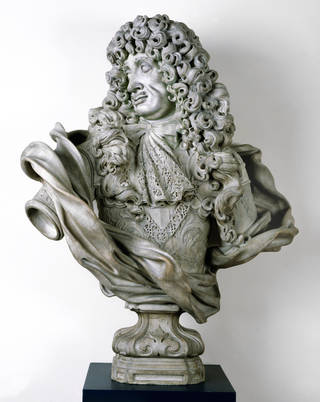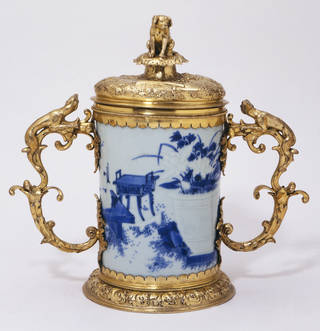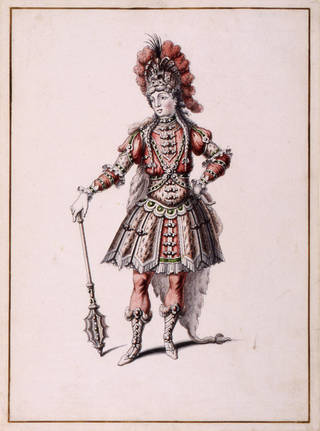Baroque Style in the Arts Can Be Described as
The Baroque style
The Baroque is a highly ornate and elaborate way of architecture, art and pattern that flourished in Europe in the 17th and first half of the 18th century. Originating in Italy, its influence quickly spread beyond Europe and it became the first visual style to have a meaning worldwide bear upon.
A defining characteristic of the Baroque style was the manner in which the visual arts of painting, sculpture and compages were brought together, into a complete whole, to convey a single bulletin or meaning.
Baroque art and pattern addressed the viewer's senses directly, appealing to the emotions as well as the intellect. Information technology reflected the hierarchical and patriarchal society of the fourth dimension, developing through and existence used by those in power – the church building, absolute rulers and the aristocracy – to persuade as well as impress, to be both rich and meaningful. Compared to the control and advisedly balanced proportions associated with the Renaissance, Baroque is known for its movement and drama.
The showtime global fashion
Baroque'due south influence extended from Italia and France to the rest of Europe, and then travelled via European colonial initiatives, trade and missionary activeness to Africa, Asia, and Southward and Cardinal America. Its global spread saw Chinese carvers working in Indonesia, French silversmiths in Sweden and Italian hardstone specialists in France. Sculpture was sent from the Philippines to Mexico and Kingdom of spain, whilst London-made chairs went all over Europe and beyond the Atlantic, and French royal workshops turned out luxury products that were both desired and imitated past fashionable society across Europe. Still, as a style, Baroque also changed as it crossed the world, being adapted to new needs and local tastes, materials and contexts.

In China, the European pavilions were the grandest expressions of the Qing rulers' interest in the arts of Europe. These European-manner palaces were part of the Yuanming Yuan or Old Summer Palace in Beijing, the Emperor Qianlong's summer residence. Designed by Jesuit priests, the pavilions – most of which were completed between 1756 and 1766 – were based on Baroque models and included m fountains and statues. In the 1780s, a set of copperplate engravings depicting the European pavilions was commissioned. This album, a copy of which is in our drove, is an of import visual record of the pavilions as they were destroyed past English language and French troops in 1860.
A sense of drama
An important feature of Baroque art and design is its use of human being figures. Represented as allegorical, sacred or mythological, these figures helped plough the piece of work into a drama to convey detail messages and to engage the emotions of the viewer. They have a sense of realistic immediacy, every bit if they had been stopped in mid-activity. Facial expression, pose, gesture and curtain were all used to add dramatic details.
A bosom of Rex Charles II of England in our drove perfectly captures the drama of Baroque portraiture. Portrayed in an animated fashion, his head is turned to one side and an elaborate wig cascades downwards over his lace cravat and billowing mantle. Such grand Baroque images of monarchs and powerful aristocrats were more common in 17th-century French republic than in England but Charles had spent much of his youth in mainland Europe and favoured European artists. The bosom is in the tradition of flamboyant and imposing portraits of monarchs, and would have unambiguously asserted the Male monarch's status.

The functioning of compages
Baroque buildings were also dynamic and dramatic, both using and breaking the rules of classical architecture. Inside, the compages echoed theatrical techniques – painted ceilings made rooms appear as if they were open to the sky and hidden windows were used to illuminate domes and altars.
Over again, the design was used to convey specific meanings and emotions. Papal Rome became a fundamental site for religious Bizarre architecture. An example of the Baroque's theatricality can be institute in Gianlorenzo Bernini's (1598 – 1680) design for St Peter's Square. Its grand, imposing curved colonnades, centred on an obelisk, are used to both overwhelm the visitor and to bring them into the church's embrace.
Baroque compages besides shaped the way the public spaces of the city appeared. Public celebrations played an important role in the political life of a nation. Typically, such events took place out of doors and were elaborately designed spectacles. Urban squares such equally Piazza Navona in Rome and Place Louis-le-Grand (now Place Vendôme) in Paris were the backdrop for firework displays, lavish theatrical performances and processions in elaborate and expensive costumes.
Imposing compages was also used to reinforce the ability of absolute rulers, such as with the Palace of Versailles, in France – the most imitated building of the 17th century. In 1717, the Swedish architect Nicodemus Tessin the Younger compiled a "treatise on the decoration of interiors, for all kinds of royal residences, and others of distinction in both town and country", based on his own travel notes. One of the most expensive, recent innovations he recorded was the presence of mirrors so large they covered entire walls. He also noted the utilise of glass over the chimneypiece in the Male monarch'south Sleeping accommodation at Versailles.

Marvellous materials
A fascination with physical materials was central to the Baroque manner. Virtuoso art objects made of rare and precious materials had long been valued and kept in special rooms or cabinets, aslope natural history specimens, scientific instruments, books, documents and works of art. Nevertheless, during the Baroque period, the birth of modern science and the opening upwards of the world across Europe brought an increasingly serious interest in the nature and meaning of these exotic materials. Rarities such as porcelain and lacquer from Eastern asia became stylish and were imitated in Europe. New techniques, such equally marquetry (the laying of veneers of differently coloured woods onto the surface of piece of furniture), developed by French and Dutch cabinet-makers and learned from them elsewhere, were besides developed.
The value attached to such materials can be seen in a porcelain cup from our collection. Made betwixt 1630 and 1650 in Prc originally as a writing-castor jar, it later on had extravagant argent-gold mounts added in London, which transformed the brush jar into a luxurious, decorative two-handled loving cup and embrace.

Baroque ornament
Representations of the natural world, likewise as motifs derived from human and animal forms, were popular decorative features. The well-nigh widespread form of Baroque floral decoration was a running scroll, often combined with acanthus – a stylised version of a real found of the same name. A late 17th-century tankard in our collection features lavish floral decoration. The leaves of the flowers have been turned into scrolling leaf, while the flowers themselves have striped petals, likely to represent a tulip, another central motif of Baroque art.

The auricular style, which featured soft, fleshy abstract shapes, besides emerged in the early on 17th century, creating an outcome that was cryptic, suggestive and baroque. In fact, the term 'Bizarre' was a later invention – 'baroque' was one of the words used at the time for the style we acquaintance every bit Baroque today.
Theatre
The theatre was a setting for magnificent productions of drama, ballet and opera – a new art form at that time. With their ornate costumes, complex stage sets and ingenious machinery, these performances created wonder and awe. Theatre was pop both with the public and at court. Written by Jean-Baptiste Lully for the French courtroom of Louis Xiv (reigned 1643 – 1715), the opera Atys was such a favourite with the Male monarch that it became known as "The King's Opera". Our collection includes a pen and ink pattern for the costume of the grapheme Hercules in Atys. He is shown in a ballet pose, wearing a Roman-fashion costume, and identified by his gild and lion skin.

Theatre also played a role in the power struggles between European courts. Rulers vied to outdo each other in the magnificence of their productions. In France, theatre and opera also became a cardinal element of Louis Xiv's cultural policy, which was used to control the nobility and express his ability and magnificence. In the early 18th century, the theatre building itself acquired new importance as proof of courtly, civic or technological power. The resulting new buildings beyond Europe established the theatre in the form we know today.
However, by the mid-18th century, the Baroque manner seemed increasingly out of step with the mood of the time, which placed increasing emphasis on reason and scientific enquiry. Baroque was criticised as an "immoral" style and art and blueprint turned away from its use of emotion, drama and illusion, returning to a simpler style inspired by classical artifact. It was only in the belatedly 19th century that the style began to be critically reappraised again.

Background epitome: Painted mirror, probably past Antoine Monnoyer, 1710 – xx, England. Museum no. West.36:1-iii-1934. © Victoria and Albert Museum, London
Source: https://www.vam.ac.uk/articles/the-baroque-style
0 Response to "Baroque Style in the Arts Can Be Described as"
Post a Comment